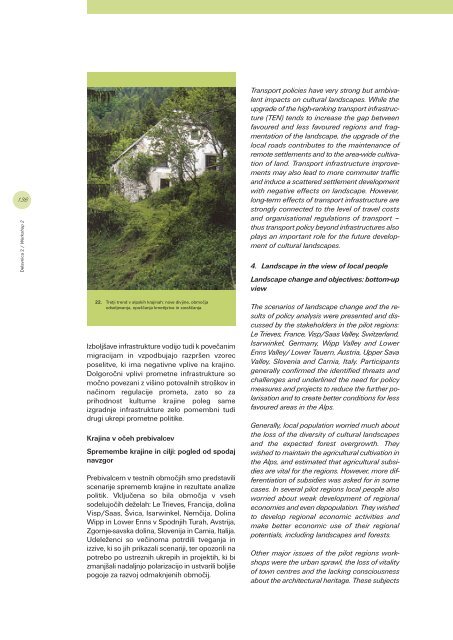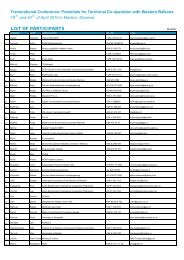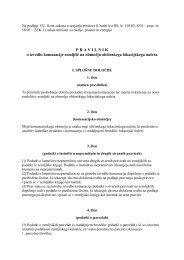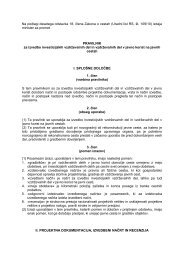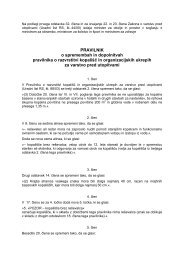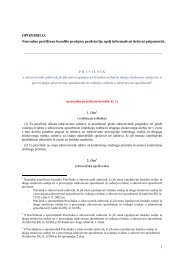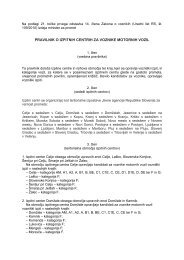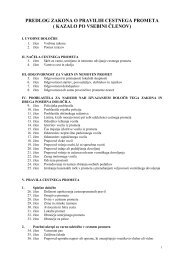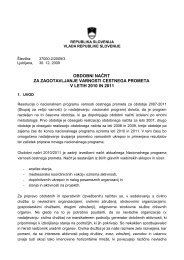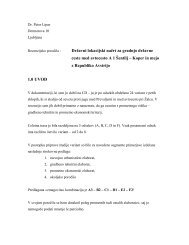evropska konvencija o krajini - Ministrstvo za infrastrukturo in prostor
evropska konvencija o krajini - Ministrstvo za infrastrukturo in prostor
evropska konvencija o krajini - Ministrstvo za infrastrukturo in prostor
Create successful ePaper yourself
Turn your PDF publications into a flip-book with our unique Google optimized e-Paper software.
136Delavnica 2 / Workshop 2Transport policies have very strong but ambivalentimpacts on cultural landscapes. While theupgrade of the high-rank<strong>in</strong>g transport <strong>in</strong>frastructure(TEN) tends to <strong>in</strong>crease the gap betweenfavoured and less favoured regions and fragmentationof the landscape, the upgrade of thelocal roads contributes to the ma<strong>in</strong>tenance ofremote settlements and to the area-wide cultivationof land. Transport <strong>in</strong>frastructure improvementsmay also lead to more commuter trafficand <strong>in</strong>duce a scattered settlement developmentwith negative effects on landscape. However,long-term effects of transport <strong>in</strong>frastructure arestrongly connected to the level of travel costsand organisational regulations of transport –thus transport policy beyond <strong>in</strong>frastructures alsoplays an important role for the future developmentof cultural landscapes.4. Landscape <strong>in</strong> the view of local peopleLandscape change and objectives: bottom-upview22. Tretji trend v alpskih kraj<strong>in</strong>ah: nove divj<strong>in</strong>e, območjaodseljevanja, opuščanja kmetijstva <strong>in</strong> <strong>za</strong>raščanja.Izboljšave <strong>in</strong>frastrukture vodijo tudi k povečanimmigracijam <strong>in</strong> vzpodbujajo razpršen vzorecposelitve, ki ima negativne vplive na kraj<strong>in</strong>o.Dolgoročni vplivi prometne <strong>in</strong>frastrukture somočno pove<strong>za</strong>ni z viš<strong>in</strong>o potovalnih stroškov <strong>in</strong>nač<strong>in</strong>om regulacije prometa, <strong>za</strong>to so <strong>za</strong>prihodnost kulturne kraj<strong>in</strong>e poleg sameizgradnje <strong>in</strong>frastrukture zelo pomembni tudidrugi ukrepi prometne politike.Kraj<strong>in</strong>a v očeh prebivalcevSpremembe kraj<strong>in</strong>e <strong>in</strong> cilji: pogled od spodajnavzgorPrebivalcem v testnih območjih smo predstaviliscenarije sprememb kraj<strong>in</strong>e <strong>in</strong> rezultate analizepolitik. Vključena so bila območja v vsehsodelujočih deželah: Le Trieves, Francija, dol<strong>in</strong>aVisp/Saas, Švica, Isarw<strong>in</strong>kel, Nemčija, Dol<strong>in</strong>aWipp <strong>in</strong> Lower Enns v Spodnjih Turah, Avstrija,Zgornje-savska dol<strong>in</strong>a, Slovenija <strong>in</strong> Carnia, Italija.Udeleženci so več<strong>in</strong>oma potrdili tveganja <strong>in</strong>izzive, ki so jih prika<strong>za</strong>li scenariji, ter opozorili napotrebo po ustreznih ukrepih <strong>in</strong> projektih, ki bizmanjšali nadaljnjo polari<strong>za</strong>cijo <strong>in</strong> ustvarili boljšepogoje <strong>za</strong> razvoj odmaknjenih območij.The scenarios of landscape change and the resultsof policy analysis were presented and discussedby the stakeholders <strong>in</strong> the pilot regions:Le Trieves, France, Visp/Saas Valley, Switzerland,Isarw<strong>in</strong>kel, Germany, Wipp Valley and LowerEnns Valley/ Lower Tauern, Austria, Upper SavaValley, Slovenia and Carnia, Italy. Participantsgenerally confirmed the identified threats andchallenges and underl<strong>in</strong>ed the need for policymeasures and projects to reduce the further polarisationand to create better conditions for lessfavoured areas <strong>in</strong> the Alps.Generally, local population worried much aboutthe loss of the diversity of cultural landscapesand the expected forest overgrowth. Theywished to ma<strong>in</strong>ta<strong>in</strong> the agricultural cultivation <strong>in</strong>the Alps, and estimated that agricultural subsidiesare vital for the regions. However, more differentiationof subsidies was asked for <strong>in</strong> somecases. In several pilot regions local people alsoworried about weak development of regionaleconomies and even depopulation. They wishedto develop regional economic activities andmake better economic use of their regionalpotentials, <strong>in</strong>clud<strong>in</strong>g landscapes and forests.Other major issues of the pilot regions workshopswere the urban sprawl, the loss of vitalityof town centres and the lack<strong>in</strong>g consciousnessabout the architectural heritage. These subjects


